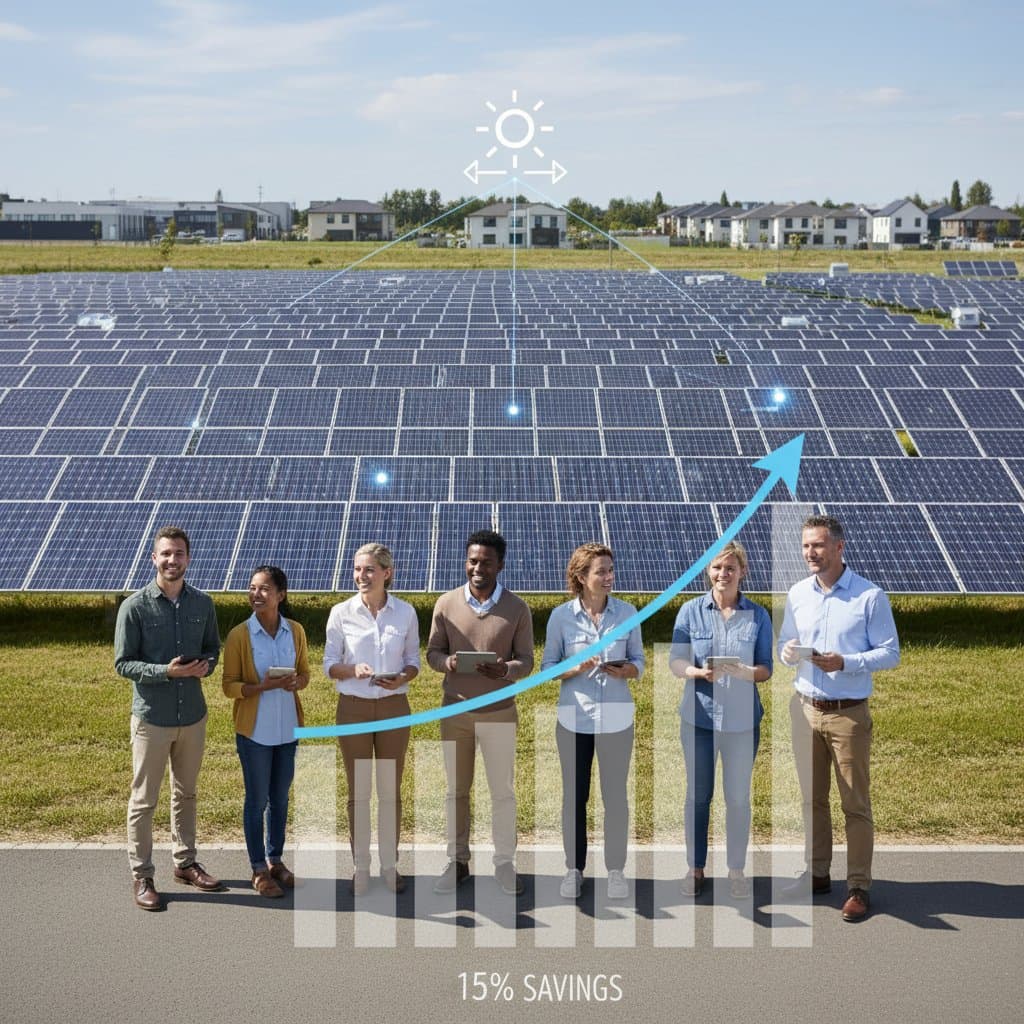Cut Your Electric Bills by 15% Through Community Solar
Shared solar projects are transforming energy access across the United States. Households and businesses now reduce electric bills by up to 15 percent without the need for rooftop panels. These initiatives, called community solar, connect multiple subscribers to an off-site solar array, delivering bill credits through local utilities.
The approach gains momentum as states update regulations, developers obtain funding, and utilities upgrade systems for shared energy distribution. Data from the Solar Energy Industries Association indicates that community solar capacity surpasses several gigawatts nationwide, with numerous projects active or underway. Arrays typically span 1 to 5 megawatts and occupy leased farmland, closed landfills, or idle land, serving renters, low-income families, small enterprises, and public organizations seeking solar advantages minus upfront expenses or upkeep.
Understanding Community Solar Mechanics
Developers build and manage mid-sized photovoltaic arrays tied to the grid in standard community solar setups. Subscribers claim a slice of the array's output, calculated in kilowatt-hours or capacity percentage. Utilities issue monthly bill credits reflecting each participant's generated share.
State formulas determine credit values, often tied to retail or avoided-cost rates. Participants pay the provider a discounted fee for their portion, yielding net savings of 10 to 15 percent over utility prices. Flexible terms prevail, with many contracts permitting cancellation on short notice, ideal for mobile renters or relocating customers.
John Farrell, director of the Energy Democracy Initiative at the Institute for Local Self-Reliance, highlights the model's inclusivity. "Community solar removes the biggest barriers to participation, including cost, roof suitability, and home ownership," he said. "Anyone with an electric bill can take part."
Overcoming Rooftop Limitations
The U.S. Department of Energy reports that almost half of households face obstacles to rooftop solar, such as shading, unsuitable roofs, or tenancy. Community solar counters this by relocating production off-site while preserving personal savings.
Growth accelerates in states with robust policies, including New York, Minnesota, Massachusetts, Colorado, and Illinois. Regulators there impose subscription limits, billing protocols, and low-income mandates for fair distribution. Additional states launch pilots and rules to replicate these frameworks.
Developers benefit from revenue stability akin to power purchase agreements, but with broader buyer pools. Projects serve hundreds of residential users rather than single entities, easing financing and minimizing risks. Investors and banks recognize community solar as a reliable investment backed by steady returns.
Key Installation and Design Elements
Community solar employs utility-scale technology scaled down, featuring single-axis trackers, string inverters, and bifacial panels suited for ground mounts. Structures emphasize rapid setup and minimal materials to control costs.
Matt Thompson, vice president of engineering at a Colorado-based national EPC contractor, notes efficiency gains. "We build these arrays using modular skids and preassembled wiring harnesses," he said. "That cuts installation time by about 25 percent compared with custom-designed projects."
Helical piles and ground screws suit diverse soils, enabling swift deployment without concrete and simplifying site restoration. Prefabrication and refined designs compress timelines, often activating projects months after grid approval.
Core Business Operations in Shared Solar
Providers adopt diverse models, from full-service developers handling sites to billing, to collaborations with utilities or managers. Revenue flows from subscriber fees and renewable energy credits.
Utilities manage crediting via virtual net metering, allocating shares to participants' accounts. This demands sophisticated software for multi-user tracking. Some utilities build in-house tools; others use external solutions.
Specialized firms like Arcadia, Ampion, and Perch Energy oversee enrollment, payments, and regulations. They scale operations for large subscriber bases and fulfill low-income quotas, ensuring program compliance.
Policy Influences and Hurdles
State policies shape community solar's trajectory, specifying credit methods, enrollment, and grid ties. Capacity caps or pilots test viability before expansion.
Wood Mackenzie analysis predicts surges in states standardizing interconnections and credit evaluations. "Developers need predictability on both costs and compensation," said Michelle Davis, principal analyst for distributed solar. "When states establish clear rules, investment follows quickly."
Interconnection delays plague queues, especially rural grids with capacity constraints. Smaller developers face financing scrutiny over churn and credit issues. Anchor tenants, like institutions securing output portions, counter risks while prioritizing residential access.
Tangible Economic and Ecological Impacts
Subscribers trim energy expenses directly. Projects generate construction and maintenance employment locally. Landowners secure lease income from unused properties.
Each megawatt offsets thousands of pounds of carbon emissions lifetime, aiding renewable standards and sustainability aims by supplanting fossil fuels.
Counties gain tax revenue from facilities with low infrastructure needs. Cities collaborate to direct capacity toward public buildings or housing, broadening clean energy reach.
Safeguards for Participants
Regulators prioritize protections amid growth, mandating clear disclosures on terms, cancellations, and savings projections. Rates appear transparently; ads undergo scrutiny against false promises.
The Coalition for Community Solar Access issues guidelines on contracts, service, and privacy. "Trust is critical," said Jeff Cramer, executive director. "Subscribers need to understand exactly how their savings are calculated and what happens if they move or switch utilities."
Utilities streamline enrollment via online portals, minimizing errors and enhancing data flow with operators.
Prospects for Community Solar Growth
Analysts forecast swift capacity increases with policy openings and billing upgrades. Monitoring tech, remote oversight, and storage pairings boost output and grid support.
Batteries emerge in designs, enabling peak delivery and market participation via lithium-ion systems.
Institutions subscribe in bulk—universities, data centers, retailers—to fulfill green goals sans on-site builds.
Steps to Join Community Solar
Consumers start by checking state registries or utility sites for projects. Submit a recent bill to match usage and size subscription; enrollment follows promptly.
Developers and installers leverage policy shifts, tech advances, and management expertise to thrive. Mastery of interconnections, mounts, and tools positions them for market gains.
Community solar extends beyond individual savings, fostering economic vitality and environmental progress. This rooftop-free path invites millions into clean energy, reshaping access nationwide.
